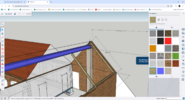- Joined
- 8 Oct 2020
- Messages
- 38
- Reaction score
- 0
- Country

So I'm making progress with my block piers, further to this thread:

 www.diynot.com
www.diynot.com
For those that read that one, I have used hollow blocks (infilled with concrete) laid in pairs staggered and every 4th course it is keyed into the 9" brick wall, I've had to chop into it in some places, other places the keyed in parts happened to fall within an existing window opening (that I've blocked up anyway). Here's one of the piers, the hardest one! I'm just above the window now and will be casting the padstone in place in the next few days all being well. You can also see the remains of the existing roof structure. Excited to hear people's comments on my set-up and the state of the project

To briefly summarise, I am altering an existing outbuilding (to be used as a workshop) to have a vaulted ceiling by installing a large steel beam rested onto two piers at each end as illustrated in my sketchup model below.

I have come across an issue that is a result of my intent to retain the existing brick structure. This issue did not exist with the existing roof structure as the existing rafters are little 4" rafters resting on purlins and meeting at a ridge board. It's to do with the end of the rafter where it will meet the wall plate. The upper side of the new 7x2 rafters I will use will align with the upper edge of the existing gable end as seen in the above so retaining the same profile. The upper end will be beaked onto timber which in turn is fastened to the steel and then I will install collar ties across.
So what happens is this:

So I guess I will have to knock down a course or two of the existing walls to allow something like this, which will also allow me to fasten the fascia board too:

I'm not sure what issues this is going to create yet! Anyone had to do this or have an alternative idea?

Pier design and tie-in to support 10.2m steel ridge beam for roof
I have an old farm building that I want to re-roof with a load bearing steel ridge beam. Currently the roof comprises a few beefy king post trusses, approx. 8x5 (?) purlins and 4x2 rafters, all have had it. The building is around 5.5m wide and 10.2m long. I intend to support new 6x2 rafters off...
 www.diynot.com
www.diynot.com
For those that read that one, I have used hollow blocks (infilled with concrete) laid in pairs staggered and every 4th course it is keyed into the 9" brick wall, I've had to chop into it in some places, other places the keyed in parts happened to fall within an existing window opening (that I've blocked up anyway). Here's one of the piers, the hardest one! I'm just above the window now and will be casting the padstone in place in the next few days all being well. You can also see the remains of the existing roof structure. Excited to hear people's comments on my set-up and the state of the project
To briefly summarise, I am altering an existing outbuilding (to be used as a workshop) to have a vaulted ceiling by installing a large steel beam rested onto two piers at each end as illustrated in my sketchup model below.
I have come across an issue that is a result of my intent to retain the existing brick structure. This issue did not exist with the existing roof structure as the existing rafters are little 4" rafters resting on purlins and meeting at a ridge board. It's to do with the end of the rafter where it will meet the wall plate. The upper side of the new 7x2 rafters I will use will align with the upper edge of the existing gable end as seen in the above so retaining the same profile. The upper end will be beaked onto timber which in turn is fastened to the steel and then I will install collar ties across.
So what happens is this:
So I guess I will have to knock down a course or two of the existing walls to allow something like this, which will also allow me to fasten the fascia board too:
I'm not sure what issues this is going to create yet! Anyone had to do this or have an alternative idea?


